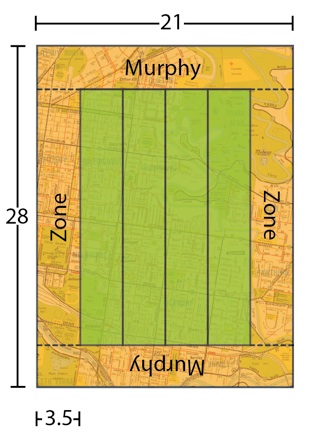Getting lost and found in the Murphy zone
by Burkard Polster and Marty Ross
The Age, 27 September 2007
It is a dark and stormy night; the rain is falling in torrents. Steering with one hand and flipping the pages of your trusty Melway with the other, you navigate a course through unfamiliar suburbs, …. when the Melway curse strikes: the place you are looking for lies irritatingly close to the edge of the map.
This familiar scenario is known as Murphy’s Law of Melway. Unlike many other purported Murphy Laws, this one is a law, an unavoidable curse. Here is an easy way to see this. The diagram shows the central part of a typical Melway page surrounded by the dreaded Murphy Zone, a thin, 3.5 cm wide strip of frustration. At first glance, it may appear that the central region is much larger than the Murphy Zone. However, upon closer inspection you can see that both the central part and the Zone are composed of the same four rectangles and therefore have equal area---your chances of ending up in the Murphy Zone is exactly 50%.

There are now two ways to lessen the effect of the Murphy Zone. First, for a given area, it is not hard to show that the Murphy Zone is smallest for square maps. (We can do even better, in fact best of all, if we make our maps circular). Secondly, we can reduce the fractional area of the Murphy Zone simply by making the maps larger. But of course, attempting to use a Melway that is larger than your car would present its own challenges.
Copyright 2004-∞ ![]() All rights reserved.
All rights reserved.